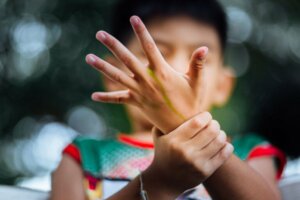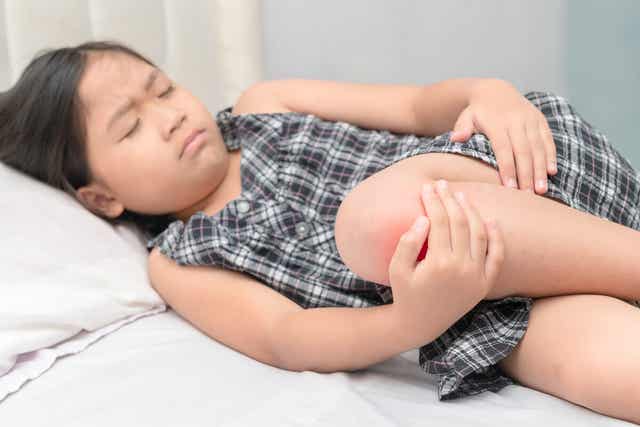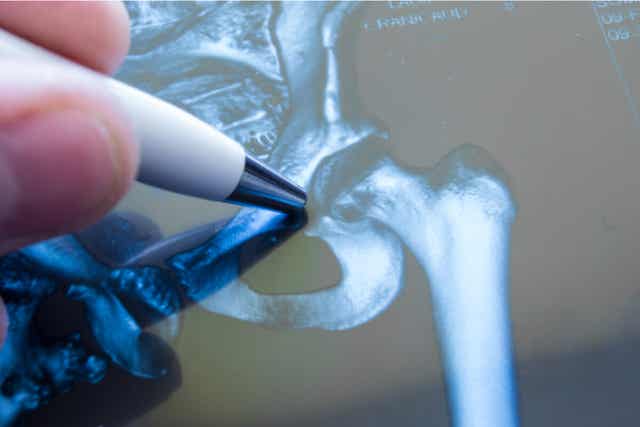Juvenile Idiopathic Arthritis: Causes and Treatments


Written and verified by the biologist Samuel Antonio Sánchez Amador
Juvenile idiopathic arthritis is a rheumatic disease without a clear origin, and it’s most common during childhood. There are between 1.6 to 23 cases per 100,000 children under 16 years old, and about 3.8 to 400 cases per 100,000 teens over 16. Depending on the region, there are many differences in how it affects children.
In any case, the term juvenile idiopathic arthritis (JIA) doesn’t point to a single clinical picture. On the other hand, it refers to several subtypes of conditions. It’s important to keep in mind that this concept includes the most common forms of pediatric chronic inflammatory arthritis.
Of all the variants, oligoarthritis is the most common, accounting for 50-60% of cases. If you want to know more about this group of diseases, keep reading.
Types of juvenile idiopathic arthritis and their symptoms
According to the StatPearls portal, juvenile idiopathic arthritis is a group of inflammatory arthritis with no known cause that affects children under 16 years old and lasts for 6 weeks or longer. Before, the term was split into 2 different concepts: juvenile chronic arthritis (JCA) and juvenile rheumatoid arthritis (JRA). In 1995, they became one.
Following the consensus in 2001 by the International League of Associations for Rheumatology (ILAR), there are 7 types of juvenile idiopathic arthritis. We’ll tell you more below.
To learn more: Reiter’s Syndrome or Reactive Arthritis: What is It?
1. Juvenile idiopathic arthritis: Oglioarthritis
It’s the cause of 50 t0 60% of cases. This variant affects 1 to 4 joints, mainly the largest ones like elbows, wrists, or knees. It’s most common in early childhood, peaking at around 2-4 years old.
In addition, it has three other subforms, depending on the interval of appearance. They are:
- Typical oligoarthritis doesn’t extend beyond 6 months.
- Persistent lasts the entire pathological course.
- Extended exceeds 6 months.

2. Positive polyarthritis for rheumatoid factor (RF)
Rheumatoid factor can be considered a protective IgM-type antibody, since it’s found in high concentrations in the blood during persistent infections. Normally, it forms complexes that inflammatory cells phagocytose, which helps the immune system.
Unfortunately, genetic mutations can make this factor over-exposed and have prolonged inflammatory activity. So, 80% of patients with this condition are RF positive. For this reason, juvenile polyarthritis can also be associated with rheumatoid factor dysfunction.
Rheumatoid factor-positive polyarthritis affects only 5-10% of children with JIA, so it’s not very common. According to the Spanish Society of Rheumatology (SSR), this variant is common in young people between 11 and 16 years old. First, they start with nonspecific symptoms. It affects 5 or more joints during the first 6 months.
In addition, it is a symmetric condition. If one side of the body becomes inflamed, the other side does too. Usually, it affects small joints, like wrists and the joint structures in the hands and feet.
3. Rheumatoid factor (RF) negative polyarthritis
This variant affects 20% of children with this type of arthritis, making it the second most common, after oligoarthritis. Like positive RF, it affects 5 joints or more during the first 6 months but is negative for the rheumatoid factor (RF) test.
4. Psoriatic arthritis
It only occurs in 2% of patients with juvenile arthritis and is biphasic. This means it has two peaks. The first happens between 2-4 years, and the other between 9-11 years. As its name states, joint pain comes with psoriasis, a skin condition that causes scaly lesions.
With this condition, the patient’s immune system wrongly redirects itself. CD4+T cells release cytokines and trigger inflammatory events, causing the outer epidermal layer to grow larger than it should (local epidermal hyperplasia). Then, it causes joint inflammation.
For psoriatic arthritis to be diagnosed, it needs to meet at least 2 of the following parameters, in addition to joint pain:
- Dactylitis: inflammation of the fingers and toes. Often, it happens in the fingers of the affected limb.
- Nail dimples: typical lesions that you can see on the nails.
- Onycholysis: one or more nails separated from the nail bed.
- Family history of first-degree psoriasis.
5. Systemic arthritis
As indicated by the Spanish Association of Pediatrics (SAP), systemic arthritis affects 5-15% of patients with JIA. Unlike the others, there is no clear connection to either gender and age. This variant can affect the entire body (at least one joint) and also has a daily fever for at least three days.
The fever shows up in peaks, rising to 104ºF at times. Swollen lymph nodes, evanescent erythematous rashes, hepatomegaly (enlargement of the liver), splenomegaly (enlargement of the spleen), or serositis inflammation of the adipose tissue) may also occur.
For JIA to be systemic, there must be fever and one of the other signs, besides joint pain.
6. Arthritis related to enthesitis
This happens to 10-15% of patients with JIA, and takes place in children older than 6. Enthesitis is an inflammatory process of the enthesis, which is where a tendon, muscle, and ligament meets your bone. It affects the knees, hips, pelvis, and even the digestive tract, like with ulcerative colitis.
This variant is associated with a genetic factor, HLA-B27. Those who are positive for it have arthritis related to enthesitis.
7. Undifferentiated arthritis
It represents approximately 10% of the total cases. Also, it doesn’t meet any of the criteria we mentioned above. It can also be a type of JIA that meets the criteria for two or more of the categories.
Causes and risk factors
According to the Rheumatology and Therapy portal, the cause of juvenile idiopathic arthritis is still a mystery. Specialists believe that many of its variants are from misdirected immune responses after an exogenous trigger, like a severe infection. However, this isn’t completely proven yet.
Researchers are looking at the role of pathogens such as parvovirus, Epstein-Barr virus, enteric bacteria, and other possible triggers of JIA. However, the results are still inconclusive. Childhood infections, stress, and trauma seem to be the 3 factors that, together, lead to idiopathic arthritis.
However, there’s also a clear genetic component. There are variations of human leukocyte antigens (HLA) and their genes could predispose to certain types of JIA, in addition to other immune events, like uveitis.
Possible complications
According to the Pediatría Integral medical portal, chronic anterior uveitis is the most common complication, since it occurs in 10-30% of all cases. It involves inflammation of the front part of the eye in attacks that last a few days or weeks, and end with treatment.
In many cases, the cause of uveitis is unknown. Sometimes, it’s linked to the same failed autoimmune reactions that trigger arthritis. It’s important to prevent this complication since it can lead to glaucoma, cataracts, and other problems.
Diagnostic tests for juvenile idiopathic arthritis
The National Library of Medicine shows us, in detail, how doctors diagnose juvenile idiopathic arthritis. First, the physical exam can give us some clues since the patient usually has swollen, hot, red joints that hurt to touch.
In any case, each type of JIA is different. As we have seen, the psoriatic variant has skin peeling with swollen lymph nodes. For this reason, you’ll need different tests:
- Blood tests: Here, circulating rheumatoid factor (RF) is in the blood, if present. The erythrocyte sedimentation rate (ESR), the presence of antinuclear antibodies (ANA) are looked at and used to make a complete blood count.
- X-rays are used to quantify the damage and condition of the affected joints.
- Regular eye exams: Since uveitis affects up to 30% of children with JIA, they should see an eye doctor regularly.
- MRIs and other imaging tests: These rule out fractures and superficial injuries.
Beyond all these tests, professionals will follow the same classification criteria that we showed you to diagnose the specific type of JIA. If the patient shows signs of several of the categories, they have undifferentiated juvenile idiopathic arthritis.

Possible treatments for juvenile idiopathic arthritis
As indicated by the portals we mentioned, juvenile idiopathic arthritis requires a multi-disciplinary approach that is responsible for managing both the pain of the disease and the possible psychological effects, as well as the conditions that arise from it. Below, we’ll talk about two different but complementary treatments.
1. Pharmacological treatment for juvenile idiopathic arthritis
Non-steroidal anti-inflammatory drugs (NSAIDs) are the long-term treatment for all forms of JIA. In any case, it’s recommended to change the strategy if the arthritis is still as active 2 months later as the beginning. Only a few NSAIDs are approved for children: naproxen and ibuprofen are the most common.
On the other hand, intra-articular corticosteroid injections are widely used in children with JIA, especially those with oligoarthritis. Oral systemic corticosteroids can also be prescribed, but only in cases where there are symptoms beyond the affected joint areas.
Finally, the anti-rheumatic drug methotrexate (MTX) is another of the drugs of choice for some types of cancer and autoimmune diseases, like rheumatoid arthritis and JIA. Doctors prescribe them in doses of 10 milligrams per square meter of body, once a week, orally.
2. Non-pharmacological treatment
In non-pharmacological treatment, there are changes in lifestyle and seeking help from other professionals. For example, a visit to a physical therapist can help children maintain muscle tone and range of motion.
On the other hand, psychotherapy is useful for managing the pain and discomfort of a chronic condition.
You may be interested in: Septic Arthritis: The Causes, Symptoms, and Treatment
There is no single juvenile idiopathic arthritis disease
Juvenile idiopathic arthritis doesn’t refer to a single disease, but to a set of conditions that cause joint pain in children under 16. Each variant has different discomforts and risks. Therefore, they each must be treated autonomously.
Unfortunately, this condition has no cure. Exercising, leading a healthy lifestyle, and taking care of their bodies will always help children to cope with these conditions correctly, especially if the doctors give the best treatment.
All cited sources were thoroughly reviewed by our team to ensure their quality, reliability, currency, and validity. The bibliography of this article was considered reliable and of academic or scientific accuracy.
- Thatayatikom, A., & De Leucio, A. (2020). Juvenile Idiopathic Arthritis (JIA). StatPearls [Internet].
- International League of Associations for Rheumatology (ILAR). Recogido a 17 de abril en http://www.ilar.org/
- ¿Qué es la artritis crónica juvenil? SER. Recogido a 17 de abril en https://www.ser.es/wp-content/uploads/2015/09/03.pdf
- Artritis idiopática juvenil. Criterios de clasificación. Índices de actividad. Aeped. Recogido a 17 de abril en https://www.aeped.es/sites/default/files/documentos/03_aij.pdf
- Giancane, G., Consolaro, A., Lanni, S., Davì, S., Schiappapietra, B., & Ravelli, A. (2016). Juvenile idiopathic arthritis: diagnosis and treatment. Rheumatology and therapy, 3(2), 187-207.
- Artritis idiopática juvenil, pediatría integral. Recogido a 17 de abril en https://www.pediatriaintegral.es/publicacion-2017-04/artritis-idiopatica-juvenil/
- Artritis idiopática juvenil, medlineplus.gov. Recogido a 17 de abril en https://medlineplus.gov/spanish/ency/article/000451.htm
This text is provided for informational purposes only and does not replace consultation with a professional. If in doubt, consult your specialist.








